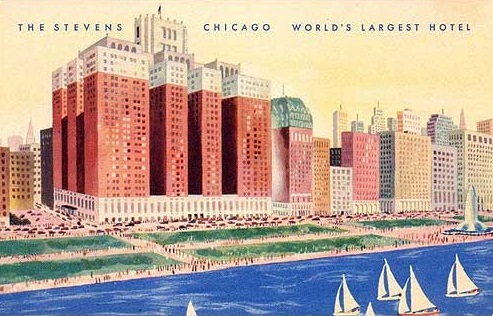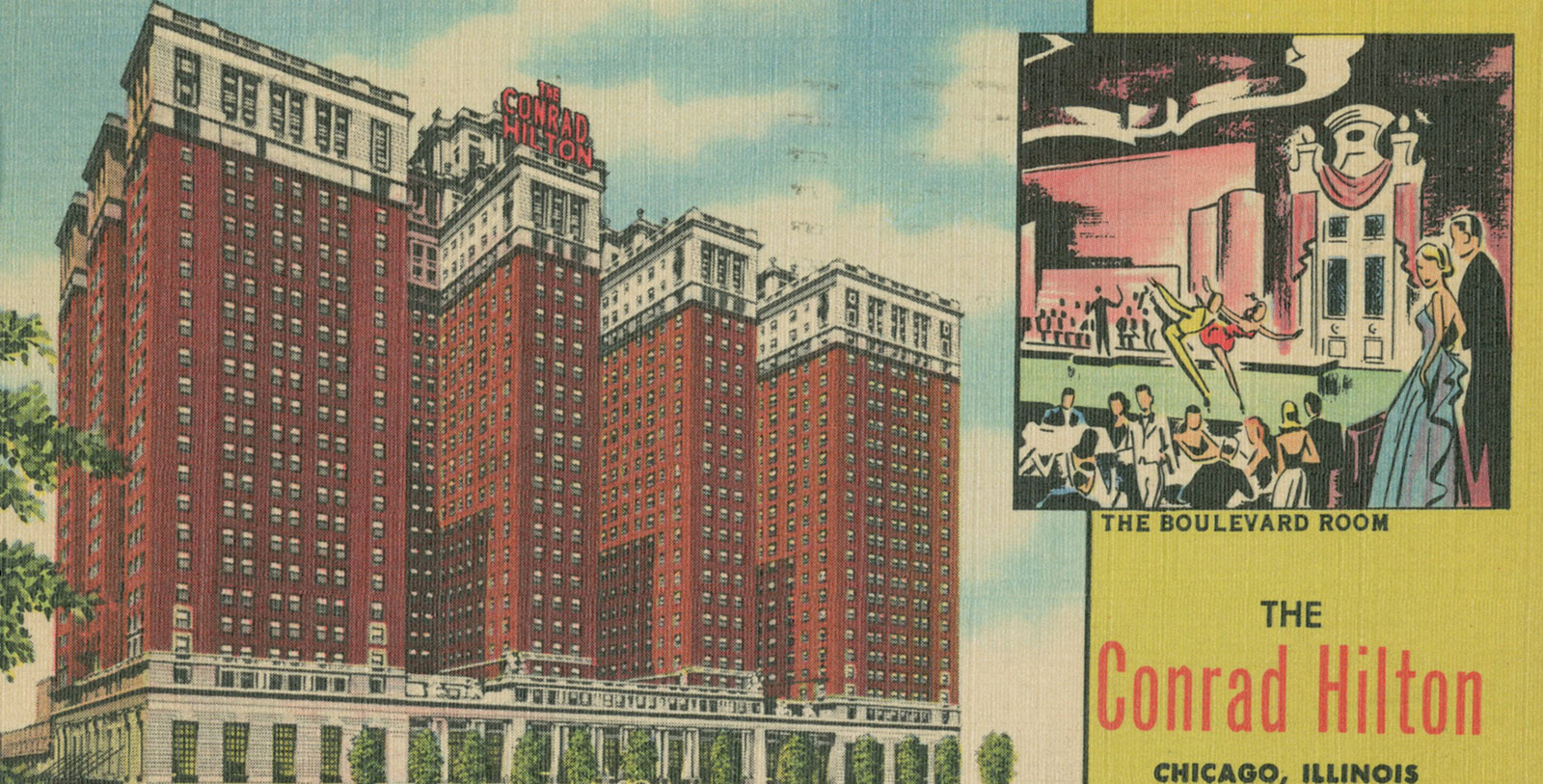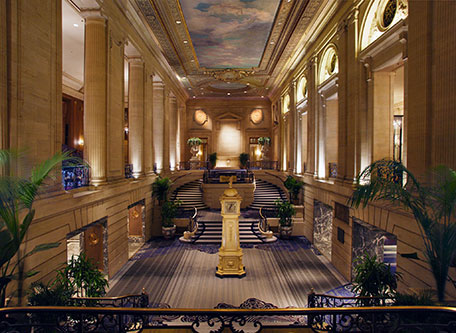Receive for Free - Discover & Explore eNewsletter monthly with advance notice of special offers, packages, and insider savings from 10% - 30% off Best Available Rates at selected hotels.
history
Discover Hilton Chicago, which was once the largest hotel in the world and named a "City Within a City" for its impressive amenities.
Hilton Chicago, a member of Historic Hotels of America since 2015, dates back to 1927.
VIEW TIMELINE
Hilton Chicago Hotel Tour
Come tour this fantastic historic hotel virtually and witness the legacy of its founder, James W. Stevens, firsthand.
WATCH NOWDesigned by architectural firm Holabird & Roche, the Hilton Chicago was originally called “The Stevens Hotel” after its two original owners, James W. and Ernest Stevens. A father-son team, both James and Ernest were among the most influential people in Chicago. The senior Stevens had actually developed his earlier prestige while operating one of the city’s most prosperous local insurance companies. But the Stevenses were also accomplished hoteliers, with Ernest even working as the general manager for the family’s upscale LaSalle Hotel. Still, the Stevens family yearned for greater financial success. Recognizing the potential of Chicago’s rapidly industrializing economy, both James and Ernest decided to construct the most magnificent hotel throughout the whole Midwest. The two men subsequently invested some $30 million into the project via a hospitality business called the “Stevens Hotel Company.” With architects from Holabird & Roche on payroll, the Stevens family broke ground on their new magnificent hotel in 1926. The work lasted for nearly a whole year and relied upon the services of several hundred craftsmen. When the project finally concluded a year later, the hotel stood as one of the largest in the world at the time. In fact, some quickly attributed it of being a “City within a City,” due to the many impressive amenities featured inside.
Amazingly, The Stevens Hotel immediately established itself as one of the most visited social gathering spots in all of Chicago. Indeed, the very first guest to reserve a guestroom was Charles G. Dawes, then serving as the Vice President of the United States. Many other illustrious individuals soon followed in Vice President Dawes’ footsteps, including countless businesspeople, dignitaries, and celebrities. The hotel even held a gala for Motion Picture Association inside its ornate grand ballroom. Some 3,000 industry insiders attended the event, including one of the founders of American cinematography, Cecil B. DeMille. But despite its unheralded popularity, The Stevens Hotel surprisingly struggled to turn a profit—a situation that became worse with the onset of the Great Depression. The situation ruined the Stevens family, who ultimately lost the hotel amid a scandal to find ways to keep the business afloat. The federal government subsequently assumed control over The Stevens Hotel, which eventually sold the building to the U.S. Army during World War II. The organization specifically used the erstwhile hotel as a barracks and training facilities for its newly enlisted servicemen. In total, around 10,000 air cadets were housed at the site, with the Grand Ballroom even getting utilized as a mess hall.
In 1945, the great hotelier Conrad Hilton purchased The Stevens Hotel and renamed it as “The Conrad Hilton Hotel” a few years later. Hilton then began to thoroughly transform the structure back into a luxurious hotel through a series of extensive renovations. Perhaps the most innovative of all his improvements was the installation of a large ice stage in the Boulevard Room Supper Club. His work succeeded in reestablishing the hotel as one of the best in the area, as it was soon back to entertaining all kinds of prominent individuals. Among the most noteworthy guests to come at the time included Bette Davis, Lauren Bacall, Dean Martin, Ella Fitzgerald, and Nat “King” Cole. Prominent international political figures also frequented the hotel once again, too, with the most notable being Queen Elizabeth II of the United Kingdom. Even Presidents Harry S. Truman, Dwight D. Eisenhower, and John F. Kennedy were all spotted inside on occasion. A member of Historic Hotels of America since 2015, this fantastic historic hotel now operates as the “Hilton Chicago.” It continues to maintain its classic integrity with all the luxury conveniences the modern traveler has come to expect. Truly few other places in Chicago are well-suited for a memorable cultural heritage experience than the historic Hilton Chicago.
-
About the Location +
Long before it would become the heart of downtown Chicago, Michigan Avenue was once just an ordinary city thoroughfare. Originally known as “Pine Street,” the road only ran the length of the Lake Michigan shoreline from the city’s southern border to the Chicago River when it first debuted in the mid-19th century. Nevertheless, some areas of Pine Street were among the best places to live in the entire metropolis, with dozens of beautiful manors and townhouses lining long sections of the road. A few municipal structures also opened, too, specifically warehouses and factories. Among the most iconic city structures built were a gorgeous water tower and pumping station. Sadly, much of Pine Street was destroyed amid the Great Chicago Fire of 1871, save for a couple historic structures (like the iconic water tower). It would not be until two architects named Daniel Burnham and Edward H. Bennett submitted plans for the city’s complete renovation that Pine Street’s potential redevelopment became a real possibility. At the behest of the Commercial Club of Chicago, both Burnham and Bennett began devising a series of integrated projects that ultimately sought to improve Chicago’s waterfront and downtown core. One of the particular regions of Chicago that attracted their attention was the dilapidated Pine Street. Burnham and Bennett specifically called for its rehabilitation into a sprawling center of local commerce. They envisioned many ornate buildings straddling the revived Pine Street, which would be filled with all kinds of storefronts and offices spaces. Furthermore, they called for Pine Street to be widened considerably, in order to grant access to the new forms of mass transit that were now proliferating throughout Chicago. While local business leaders formed the Greater North Michigan Avenue Association as a way to fund the plan in 1912, actual construction along Pine Street did not truly commence until the onset of the Roaring Twenties.
By this point, a massive boom in commercial building projects was transpiring all over the Chicago shoreline, with Pine Street becoming one of the main focal points for the construction. Transformed into a new sprawling boulevard called “Michigan Avenue,” many kinds of new structures appeared along the revitalized corridor that displayed an amazing breadth of architectural styles. Some of Chicago’s most iconic landmarks debuted along Michigan Avenue, including Tribune Tower, the Women’s Athletic Club, and the Wrigley Building. Engineers even connected the thoroughfare to the rest of Chicago by way of the double decked DuSable Bridge. Unfortunately, the onset of the Great Depression abruptly brought an end to the work occurring all over Michigan Avenue. Construction would only resume due to the efforts of another noted Chicago-based real estate developer named Arthur Rubloff. In 1947, Rubloff specifically launched a targeted campaign to reignite the creation of ornate skyscrapers through his affiliation with the Greater North Michigan Avenue Association. He even sponsored a brilliant series of plans presented by the renowned architectural firm Holabird & Root to craft many new outstanding structures. But perhaps the most telling legacy of Robloff’s was the moniker he bestowed upon the revitalized thoroughfare. Upon witnessing the wealth of gorgeous buildings that had appeared along the avenue, he decided to christen the location as the “Magnificent Mile.” The building projects continued unabetted for many years thereafter, in which they constructed such renowned landmarks as the celebrated John Hancock Center. Michigan Avenue has since remained a fixture in downtown Chicago, attracting countless visitors each year due to its wide variety of upscale storefronts, eloquent restaurants, and fascinating cultural attractions.
-
About the Architecture +
The Hilton Chicago continues to fulfill the vision of its original founders, James W. Stevens and Ernest Stevens. Their vision was to create an entirely self-sufficient “city within a city,” a place capable of offering the most extensive convention and conference facilities in a primary destination. Designed by architectural firm Holabird & Roche, this gorgeous architectural marvel cost approximately $30 million to construct. Its interiors were designed with bronze and crystal chandeliers and featured original fresco-inspired oil paintings on the ceilings. At the time, The Stevens Hotel was the largest one of its kind in the world. Nevertheless, the U.S. Army eventually acquired the building following the Stevens family’s bankruptcy during the Great Depression. It subsequently turned the erstwhile hotel into a barracks and training facility for its Army Air Force cadets in World War II. In honor of this legacy, the current hotel’s “Normandie Lounge” features parts from the French cruise liner S.S. Normandie, which was repurposed for use by the U.S. Army in World War II. (It was specifically renamed as the USS Lafayette.) Original parts from the ship are incorporated into the lounge, including chandeliers, pieces of the bars, and some of the woodwork.
In 1945, the great hotelier Conrad Hilton purchased both The Stevens Hotel and renamed it as “The Conrad Hilton Hotel” shortly thereafter. Hilton immediately began to thoroughly transform the structure back into a luxurious hotel through a series of extensive renovations. Perhaps the most innovative of all his improvements was the installation of a large ice stage in the Boulevard Room Supper Club. By the 1960s, The Conrad Hilton Hotel even sported new facilities like the International Ballroom, the Continental Ballroom, and 53,000 square feet of additional exhibition space. Then, in 1984, the original Rooftop Ballroom was converted into the massive Conrad Hilton Suite. It cost $1.6 million to construct and boasted 5,000 total square feet spread out over two levels—the 29th and 30th. Overlooking Grant Park and Lake Michigan, the suite contained a grand salon, dining room (for 14 people), private kitchen, three gorgeous bedrooms, and a library with pool table and bar! There was even a private helipad installed on the roof! The suite was President Bill Clinton’s favorite place to stay in Chicago, as he loved the pool table during his visits to the hotel. Several films and television shows also featured The Conrad Suite, including The Fugitive, Home Alone 2, and E.R.
Holabird & Roche specifically used Beaux-Arts architecture as the main source of their inspiration when it originally created the building. Although it initially became popular around the start of the 20th century, this beautiful architectural form originally began at an art school in Paris known as the “École des Beaux-Arts” during the 1830s. There was much resistance to the Neoclassism of the day among French artists, who yearned for the intellectual freedom to pursue less rigid design aesthetics. Four instructors in particular were responsible for establishing the movement: Joseph-Louis Duc, Félix Duban, Henri Labrouste, and Léon Vaudoyer. The training that these instructors created involved fusing architectural elements from several earlier styles, including Imperial Roman, Italian Renaissance, ad Baroque. As such, a typical building created with Beaux-Arts-inspired designs would feature a rusticated first story, followed by several more simplistic ones. A flat roof would then top the structure. Symmetry became the defining character, with every building’s layout featuring such elements as balustrades, pilasters, and cartouches. Sculptures and other carvings were commonplace throughout the design, too. Beaux-Arts only found a receptive audience in France and the United States though, as most other Western architects at the time gravitated toward British design principles.
-
Famous Historic Guests +
Bette Davis, actress known for her roles in All About Eve, Jezebel, and What Ever Happened to Baby Jane?
Lauren Bacall, actress known for her roles in such films like The Big Sleep, Key Largo, and To Have and Have Not.
Cecil B DeMille, director regarded today by film scholars as one of the founder of the modern American cinema.
Benny Goodman, jazz clarinetist and band leader remembered to history as the “King of Swing.”
Guy Lombardo, bandleader and violinist who sold anywhere between 100 and 300 million records worldwide.
Mary Martin, actress best remembered for her roles in such films like Peter Pan, South Pacific, and The Sound of Music.
Ella Fitzgerald, singer known for her songs “Dream a Little Dream,” “A-Tisket, A-Tasket,” and “It Don’t Mean a Thing (If It Ain’t Got That Swing).”
Dean Martin, actor known for his roles in such films like Rio Bravo, The Wrecking Crew, and the original Ocean’s 11.
Nat King Cole, musician known for his outstanding jazz recordings, as well as for being the first African American to host a television show.
Charles Lindbergh, legendary aviator who completed the first solo transatlantic flight in world history.
Amelia Earhart, pioneering aviator who was the first woman to fly solo across the Atlantic Ocean.
Douglas MacArthur, general remembered for his campaigns in the Pacific during World War II and the Korean War.
Margaret Thatcher, Prime Minister of the United Kingdom (1975 – 1990)
Queen Elizabeth II of the United Kingdom (1952 – 2022)
King Carl XVI Gustav of Sweden (1973 – present)
Betty Ford, First Lady to former President Gerald Ford (1974 – 1977)
Charles G. Dawes, 30th Vice President of the United States (1925 – 1929)
Harry S. Truman, 33rd President of the United States (1945 – 1953)
Dwight D. Eisenhower, 34th President of the United States (1953 – 1961), and Supreme Allied Commander Europe during World War II.
John F. Kennedy, 35th President of the United States (1961 – 1963)
Bill Clinton, 42nd President of the United States (1993 – 2001)
Barack Obama, 44th President of the United States (2009 – 2017)
-
Film, TV and Media Connections +
The Package (1989)
Home Alone II (1992)
The Fugitive (1993)
E.R. (1994 - 2009)
Primal Fear (1996)
My Best Friend’s Wedding (1997)
U.S. Marshals (1998)
Love & Action in Chicago (1999)
Unconditional Love (2002)
Road to Perdition (2002)
The Express (2008)
Little Fockers (2010)
-
Women in History +
Amelia Earhart: Amelia Earhart was one of the first celebrity guests to arrive at The Stevens Hotel when it first opened at the height of the Roaring Twenties. Amelia Earhart was a legendary aviator who bore the distinction of being the first female to pilot a flight across the Atlantic. Climbing aboard a Fokker Trimotor dubbed “Friendship,” Earhart and her copilot, Wilmer Stultz, began the historic trip from an airfield in Newfoundland in June of 1928. In just under a single day, Earhart and Stultz landed at Pwll in South Wales. She became an overnight international celebrity for her achievement. When Earhart returned to the United States, she was given a massive ticker-tape parade along the Canyon of Heroes in New York City. President Calvin Coolidge even held a reception in her honor at the White House shortly thereafter. Earhart then followed up her grand achievement five years later, when she completed a transatlantic solo flight from Canada to Northern Ireland. Becoming the first woman to finish such a trip alone, Congress bestowed Earhart with the Distinguished Flying Cross. Her fame only continued to grow, as tales of her accomplishments captivated countless Americans. Earhart’s celebrity status even caused her to develop a close friendship with Eleanor Roosevelt during the mid-1930s. When she was not busy flying, Earhart served as a visiting faculty member for aeronautical engineering at Purdue University, and vigorously supported the causes championed by the National Women’s Party. Earhart also founded the Ninety-Nines, an all-female international organization that supports the professional growth of female pilots. Yet, her career was tragically cut short in 1937, when she disappeared while attempting a circumnavigational trek across the globe.































